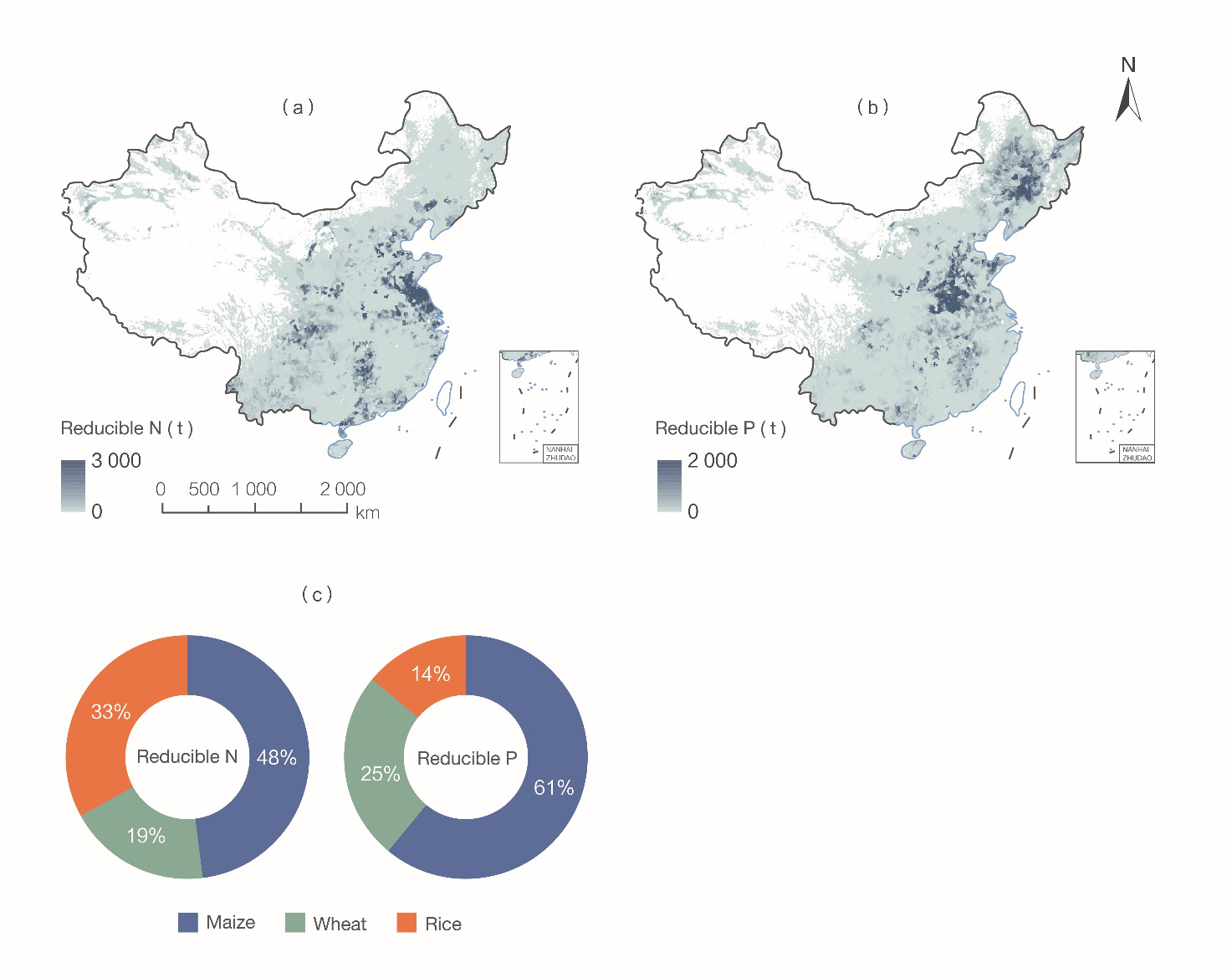SDG2: Zero Hunger
Potential for improvement of the sustainability of crop production in China(2020)
Target: 2.4 By 2030, ensure sustainable food production systems and implement resilient agricultural practices that increase productivity and production, that help maintain ecosystems, that strengthen capacity for adaptation to climate change, extreme weather, drought, flooding and other disasters and that progressively improve land and soil quality.
| Highlights |
| A remote sensing-based model was developed to estimate the yield gap (difference between potential and actual yield) of three major staple food crops. It was found that the yield gap of rice and wheat in the agriculture zone with the highest harvest area was 13.3% and 12.5% of the yield in 2015, respectively. Closing the yield gap in the zone can help meet China's forecasted demand for rice and wheat in 2030. Without loss of food production, the nitrogen and phosphorus fertilizers for the three major staple food crops in China could be reduced by 17% to 19% of the total application. Rational spatial distribution planning for different regions for increasing crop production while reducing excess fertilizer application is critical for effectively improving the sustainability of food production. |
Background
Prompting food production to meet ever increasing human demand while limiting environmental impacts is critical for realizing food security, which is the major concern of SDG 2.4. This case focuses on three indicators referring to sustainable intensification (i.e., land productivity, fertilizer pollution risk, and food security), developing models to estimate the yield gap, reducible fertilizer, and self-sufficiency of three major staple crops (i.e., rice, wheat, and maize) in China. We aim to evaluate the potential for improvement of sustainability of crop production in China.
Data used
China's Agricultural Outlook—forecasted national demand for major crops in 2030.
Remote sensing reflectance, vegetation index, meteorological data, soil data, phenology data, and yield data in major agriculture zones of three major staple food crops from 2010 to 2015.
Dataset on food production, fertilizer application, and water consumption for three major staple food crops in China in 2015.
Method
To quantify the yield potential of crops, a Remote Sensing-Crop Yield Model (RS-CYM) (Wang et al., 2020) was developed to estimate the on-farm yield of the three major grain crops in 2015 over several major agriculture zones in China. Meteorological and environmental factors were then used to divide each agriculture zone into multiple Potential Yield Zones (PYZs), and the yield potential for each PYZ was defined as the 95% quantile of the predicted pixel-level on-farm yield. The yield gap, i.e., the difference between the yield potential and averaged actual yield during the study period, was therefore obtained.
To reduce fertilizer application, input-response models for each crop in different climate zones were developed based on the yield and corresponding nitrogen/phosphate application rate. The types of fertilizer that limited crop yield were determined by employing the "law of the minimum" (Mueller et al., 2012). The demand for the types of fertilizer other than the limiting one was calculated by an input-response model. As such, the reducible amount of fertilizer was acquired.
The level of food security was determined by the degree of self-sufficiency, the ratio of total production to total consumption.
Results and analysis
Results show that the yield gap of rice in the Middle-lower Yangtze River Plain (MLYRP), the zone with the largest harvest area of rice in China, was 1.1 t/hm2 in 2015, accounting for 13.3% of the rice yield potential. Closing the yield gap of rice in the MLYRP could increase the national rice production by 5%, and help to meet the predicted total rice consumption in China in 2030, thus achieving country-level self-sufficiency.
The yield gap of wheat in the North China Plain (NCP), which is the zone with the largest harvest area of wheat in China, was 0.9 t/hm2 in 2015, accounting for 12.5% of the wheat yield potential. Such an improvement in yield could increase the wheat production of China by about 8% of the total wheat production in 2015. The potential production over NCP, added with the on-farm production of other regions over China, can fully meet the predicted demand for wheat of the country by 2030, thus achieving country-level self-sufficiency.
The yield gap of maize in the two major agriculture zones, namely, the Northeast Plain (NECP) and NCP, are 1.5 t/hm2 and 1.3 t/hm2, accounting for 16.0% and 19.0% of their maize yield potential, respectively. The improvement in production by closing the yield gap in the NECP was about 6% of the national maize production in 2015, while that in the NCP was about 5%. The potential production of maize in the two zones, added with the on-farm production over other regions, can meet 89% of the predicted demand of maize in China by 2030. Therefore, achieving self-sufficiency of maize in China in 2030 requires improvement in the yield across additional regions.

Figure 1. Spatial distribution of yield gap for rice in the NECP (a), rice in the MLYRP (b), maize in the NECP (c), maize in the NCP (d), and winter wheat in the NCP (e) in China
The reducible ratio for nitrogen and phosphorus applied for the three major staple food crops in China was between 17% and 19% in 2015, with rice having the highest reducible rate. The areas with high reducible nitrogen are located in the east and southwest of the NCP, while the areas with high reducible phosphorus are located in the NECP and western NCP (Fig. 2). Among the three crops, maize has the highest proportion of both reducible nitrogen and reducible phosphorus, accounting for 48% and 61% of the total reducible amount, respectively; wheat has the lowest proportion of reducible nitrogen, accounting for 19%; and rice has the lowest reducible phosphorus at 14%. Removing excess chemical fertilizer is essential to improve soil health and alleviate agricultural non-point source pollution. Rational planning for different regions for increasing crop production or reducing excess fertilizer application is important for improving food production while reducing environmental impacts, thus helping to achieve sustainable intensification in China.

Figure 2. Spatial distribution of reducible nitrogen (a) and phosphorus (b) applications for the three major staple food crops and the proportion for different crops (c) (Note: no data available for Taiwan province)
Outlook
The estimates of yield potential and reducible chemical fertilizer were acquired from two separate models in this case, which highlights difficulties in finding a pathway to increase crop production while removing excess fertilizer simultaneously. We will develop a new model that can couple these two factors in the future to provide useful information for regional optimization and finally deliver a sustainable cropping system to achieve food and ecological security.
Improving the sustainability of crop production faces systemic problems, for which the issues of the reduction of pesticide application and recycling of crop straw, agricultural film, and livestock excrement should be involved. Meanwhile, the achievement of sustainable intensification at the global scale remains uncertain due to climate change. In the future, more factors, including climate change, should be considered in analyses with regard to helping decision makers formulate systematic policies and regulations for a more sustainable cropping system.

